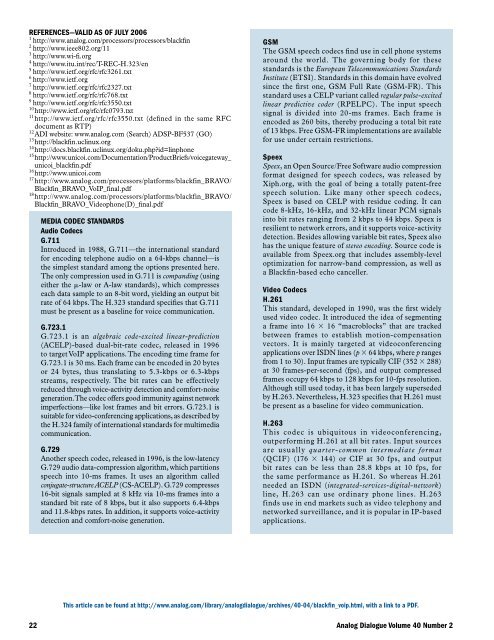Analog Dialogue Volume 40, Number2, 2006
Analog Dialogue Volume 40, Number2, 2006
Analog Dialogue Volume 40, Number2, 2006
You also want an ePaper? Increase the reach of your titles
YUMPU automatically turns print PDFs into web optimized ePapers that Google loves.
REFERENCES—VALID AS OF JULY <strong>2006</strong><br />
1 http://www.analog.com/processors/processors/blackfin<br />
2 http://www.ieee802.org/11<br />
3 http://www.wi-fi.org<br />
4 http://www.itu.int/rec/T-REC-H.323/en<br />
5 http://www.ietf.org/rfc/rfc3261.txt<br />
6 http://www.ietf.org<br />
7 http://www.ietf.org/rfc/rfc2327.txt<br />
8 http://www.ietf.org/rfc/rfc768.txt<br />
9 http://www.ietf.org/rfc/rfc3550.txt<br />
10 http://www.ietf.org/rfc/rfc0793.txt<br />
11 http://www.ietf.org/rfc/rfc3550.txt (defined in the same RFC<br />
document as RTP)<br />
12 ADI website: www.analog.com (Search) ADSP-BF537 (GO)<br />
13 http://blackfin.uclinux.org<br />
14 http://docs.blackfin.uclinux.org/doku.php?id=linphone<br />
15 http://www.unicoi.com/Documentation/ProductBriefs/voicegateway_<br />
unicoi_blackfin.pdf<br />
16 http://www.unicoi.com<br />
17 http://www.analog.com/processors/platforms/blackfin_BRAVO/<br />
Blackfin_BRAVO_VoIP_final.pdf<br />
18 http://www.analog.com/processors/platforms/blackfin_BRAVO/<br />
Blackfin_BRAVO_Videophone(D)_final.pdf<br />
MEDIA CODEC STANDARDS<br />
Audio Codecs<br />
G. 11<br />
Introduced in 1988, G.711—the international standard<br />
for encoding telephone audio on a 64-kbps channel—is<br />
the simplest standard among the options presented here.<br />
The only compression used in G.711 is companding (using<br />
either the m-law or A-law standards), which compresses<br />
each data sample to an 8-bit word, yielding an output bit<br />
rate of 64 kbps. The H.323 standard specifies that G.711<br />
must be present as a baseline for voice communication.<br />
G. 23.1<br />
G.723.1 is an algebraic code-excited linear-prediction<br />
(ACELP)-based dual-bit-rate codec, released in 1996<br />
to target VoIP applications. The encoding time frame for<br />
G.723.1 is 30 ms. Each frame can be encoded in 20 bytes<br />
or 24 bytes, thus translating to 5.3-kbps or 6.3-kbps<br />
streams, respectively. The bit rates can be effectively<br />
reduced through voice-activity detection and comfort-noise<br />
generation. The codec offers good immunity against network<br />
imperfections—like lost frames and bit errors. G.723.1 is<br />
suitable for video-conferencing applications, as described by<br />
the H.324 family of international standards for multimedia<br />
communication.<br />
G. 2<br />
Another speech codec, released in 1996, is the low-latency<br />
G.729 audio data-compression algorithm, which partitions<br />
speech into 10-ms frames. It uses an algorithm called<br />
conjugate-structure ACELP (CS-ACELP). G.729 compresses<br />
16-bit signals sampled at 8 kHz via 10-ms frames into a<br />
standard bit rate of 8 kbps, but it also supports 6.4-kbps<br />
and 11.8-kbps rates. In addition, it supports voice-activity<br />
detection and comfort-noise generation.<br />
GSM<br />
The GSM speech codecs find use in cell phone systems<br />
around the world. The governing body for these<br />
standards is the European Telecommunications Standards<br />
Institute (ETSI). Standards in this domain have evolved<br />
since the first one, GSM Full Rate (GSM-FR). This<br />
standard uses a CELP variant called regular pulse-excited<br />
linear predictive coder (RPELPC). The input speech<br />
signal is divided into 20-ms frames. Each frame is<br />
encoded as 260 bits, thereby producing a total bit rate<br />
of 13 kbps. Free GSM-FR implementations are available<br />
for use under certain restrictions.<br />
Speex<br />
Speex, an Open Source/Free Software audio compression<br />
format designed for speech codecs, was released by<br />
Xiph.org, with the goal of being a totally patent-free<br />
speech solution. Like many other speech codecs,<br />
Speex is based on CELP with residue coding. It can<br />
code 8-kHz, 16-kHz, and 32-kHz linear PCM signals<br />
into bit rates ranging from 2 kbps to 44 kbps. Speex is<br />
resilient to network errors, and it supports voice-activity<br />
detection. Besides allowing variable bit rates, Speex also<br />
has the unique feature of stereo encoding. Source code is<br />
available from Speex.org that includes assembly-level<br />
optimization for narrow-band compression, as well as<br />
a Blackfin-based echo canceller.<br />
Video Codecs<br />
H.261<br />
This standard, developed in 1990, was the first widely<br />
used video codec. It introduced the idea of segmenting<br />
a frame into 16 3 16 “macroblocks” that are tracked<br />
between frames to establish motion-compensation<br />
vectors. It is mainly targeted at videoconferencing<br />
applications over ISDN lines (p 3 64 kbps, where p ranges<br />
from 1 to 30). Input frames are typically CIF (352 3 288)<br />
at 30 frames-per-second (fps), and output compressed<br />
frames occupy 64 kbps to 128 kbps for 10-fps resolution.<br />
Although still used today, it has been largely superseded<br />
by H.263. Nevertheless, H.323 specifies that H.261 must<br />
be present as a baseline for video communication.<br />
H.263<br />
T his codec is ubiquitous in videoconferencing,<br />
outperforming H.261 at all bit rates. Input sources<br />
a re usually quarter - common inter mediate for mat<br />
(QCIF) (176 3 144) or CIF at 30 fps, and output<br />
bit rates can be less than 28.8 kbps at 10 fps, for<br />
the same performance as H.261. So whereas H.261<br />
needed an ISDN (integrated-services-digital-network)<br />
line, H.263 can use ordinary phone lines. H.263<br />
finds use in end markets such as video telephony and<br />
networked surveillance, and it is popular in IP-based<br />
applications.<br />
This article can be found at http://www.analog.com/library/analogdialogue/archives/<strong>40</strong>-04/blackfin_voip.html, with a link to a PDF.<br />
22 <strong>Analog</strong> <strong>Dialogue</strong> <strong>Volume</strong> <strong>40</strong> Number 2

















